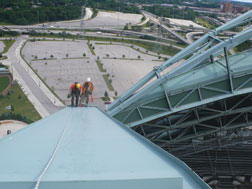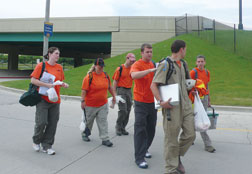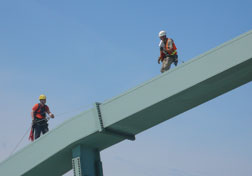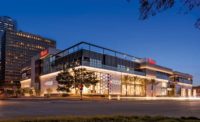 Aileen Cho/ENR Seal (right) and Prendeville finish inspecting a box-chord section. |
Michael Seal is geared up and ready to climb. The blond 29-year-old Columbus, Ohio, native sports a cornucopia of metal hooks, buckles, harnesses and belts on his athletic frame, topped off by a 600-ft-long rope that looks like a Brobdingnagian mop.
On a beautiful June morning in Milwaukee, Seal stands in the quiet interior of Miller Park, the baseball stadium for the National League Central-leading Milwaukee Brewers, and chats with Michael Brockman, project engineer with the Sigma Group, Milwaukee. Seal, who leads a six-member climbing inspection team from Burgess & Niple, Columbus, is determining a plan of action for inspecting sections of Miller Park over the next week. That is determined in part by the likelihood of the park’s adjustable roof sliding shut due to poor weather.
|
The two halves of the 10.5-acre roof consist of seven pie-slice-shaped panels. Each of the five operable panels pivots on a bearing, which forms an assembly above home plate. Panels are opened and closed by two bogies that travel along rails at the outfield walls. When opened, the moveable panels nest within the fixed panels along the first- and third-base lines. The total weight of the roof is more than 1,200 tons, and it reaches 330 ft above the playing field.
Put another way, the roof basically consists of a series of steel truss bridges. “Departments of transportation inspect their bridges every two years,” notes Brockman. “We aren’t required to, but we thought it would be prudent to be proactive.”
That sounds like efforts to create good karma for the stadium, which was the site of a fatal crane collapse during construction and needed replacement of flawed bearings. That is why B&N has a two-year $177,000 contract to inspect every roof component. One two-week inspection was performed last year and the second in June. “B&N’s technique and climbing ability made them the logistically and cost-wise obvious choice,” says Brockman. “They can get to places without cranes and scaffolds.”
 Aileen Cho/ENR |
Based on his discussion with Brockman, Seal makes his deployment decision. He sends Sanya Johnson and Brian Dietrich off to climb the cross-bracing inside the roof. Abigail Humphreys and Ann Griessmann will inspect a middle level of trusses. Seal and Brendan Prendeville will spend the morning looking at the top box chords—literally walking along the very top rim of the stadium.
“We’re out,” he tells the group, who all sport the same hefty collection of harnesses, carabiners and grions. Lugging his 600-ft of rope, which can support up to 3,000 lb, Seal begins climbing the access stairs.
A series of narrow ladders come next, as Seal and Brendan make their way up each level of stadium to the main sloping roof. A row of vertical columns topped by a horizontal beam rise from the roof—the box chord for the truss section. Essentially, the truss sections are suspended from the box chords. The inspectors will use a ladder to reach that top beam, which is about 5-ft wide.
“This is new for us,” says Seal, who joined B&N seven years ago. “It’s something different from a bridge.” There is an added advantage of no live traffic to deal with, but still plenty of bird dung.
Last summer, the team inspected the main trusses, tension cables and the box chords. This year, they’re looking at the secondary trusses and box chords. “We’ll evaluate their findings and determine the best maintenance cycle from there,” says Brockman.
 Aileen Cho/ENR Top box chord reaches as high as 330 ft as part of Miller Park�s moveable roof.
|
Seal has been on the Brooklyn Bridge, helping to install sensing monitors. He also has worked in Alaska, where bears make unwelcome visits to bridges, and in Oregon. He is one of 10 full-timers in B&N’s bridge inspection group, making some 20 trips a year throughout the U.S. But he recently was married, so the future may include fewer trips a year, he says. “The wife has to come first,” he says, clearly in love.
The team surely comes in a close second. The tight-knit group eats meals together and chat about possible plans for spending the weekend in Milwaukee: Seal and Johnson may do something athletic; Prendeville will kick back and relax; the others may do something cultural. It is a group of young, dedicated engineers combining that profession’s characteristics of focus and meticulousness with the penchant for adrenalin rushes and atypical work. Seal, one of the veterans, is a low-key, effortless leader.
“Mike has always displayed both technical proficiency and strong leadership skills,” says Mark Bernhardt, director of facility inspection for B&N. “He exhibits the situational awareness that is required of a project manager and team leader on projects that utilize climbing and industrial rope-access techniques.”
 Aileen Cho/ENR Climbers are roped off at all times, even on ladders.
|
“Teaching and mentoring is another of Mike’s assets,” Bernhardt adds. “He actively participates in the training and supervision of all of our new climbers and has been integral to the success of our bridge inspection program.”
Occasionally checking in with his team members on a walkie-talkie, Seal decides to climb the 40-ft-tall steel column’s ladder first, tied off and lugging the rope with him. “We’ll look at the bolted connections, and check for faults,” he says,
Last year, “we rappelled off the columns,” Seal recalls. He carries a little steel “suitcase” that holds the inspection book. As he inspects each section of beam, he will note any dirt, corrosion, water or cracks.
Now standing unruffled and serene high in the air, Seal enjoys the sunshine and the breeze. “This is pretty tame stuff,” he says, and strides down the sloping box chord to inspect the next section.


Post a comment to this article
Report Abusive Comment